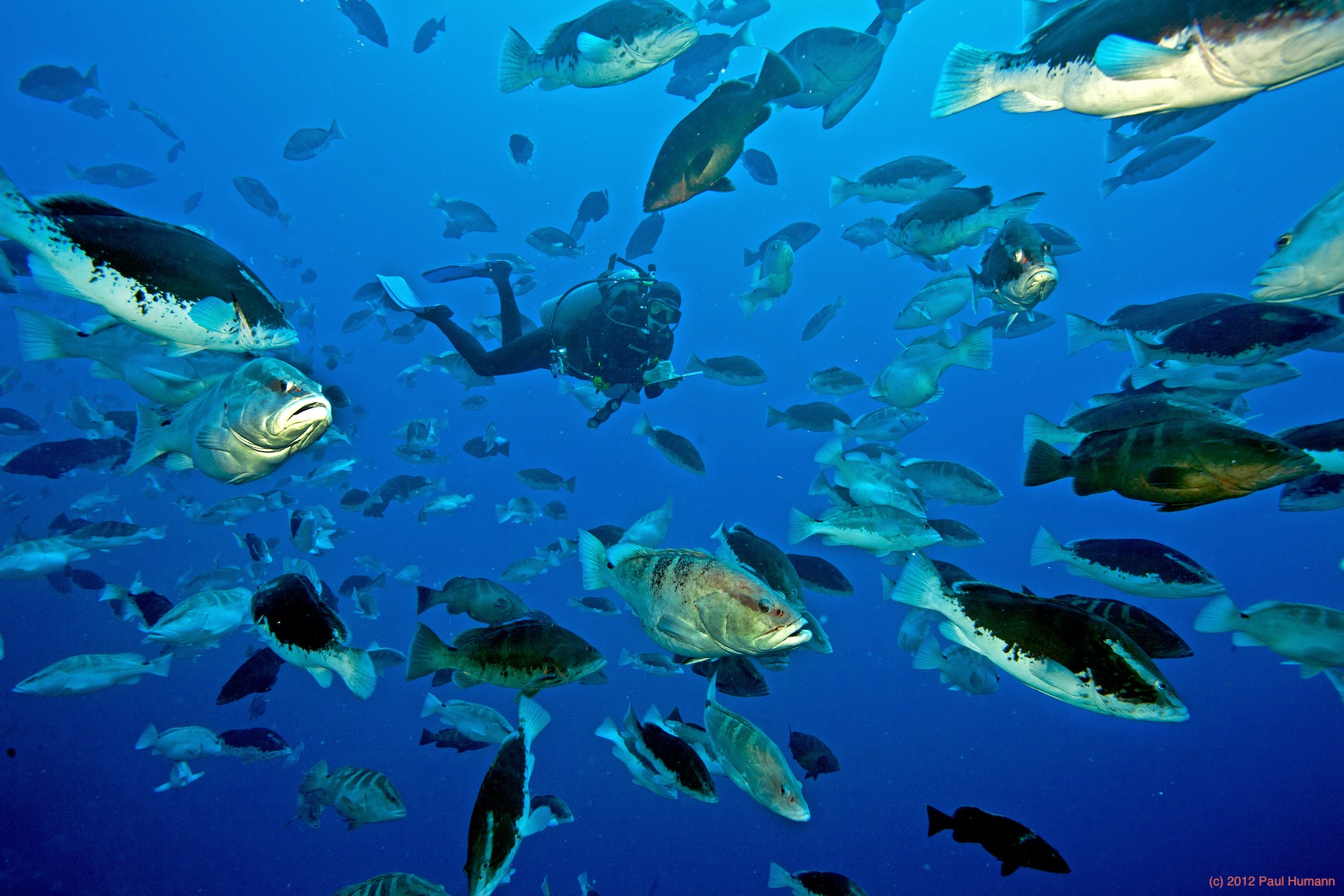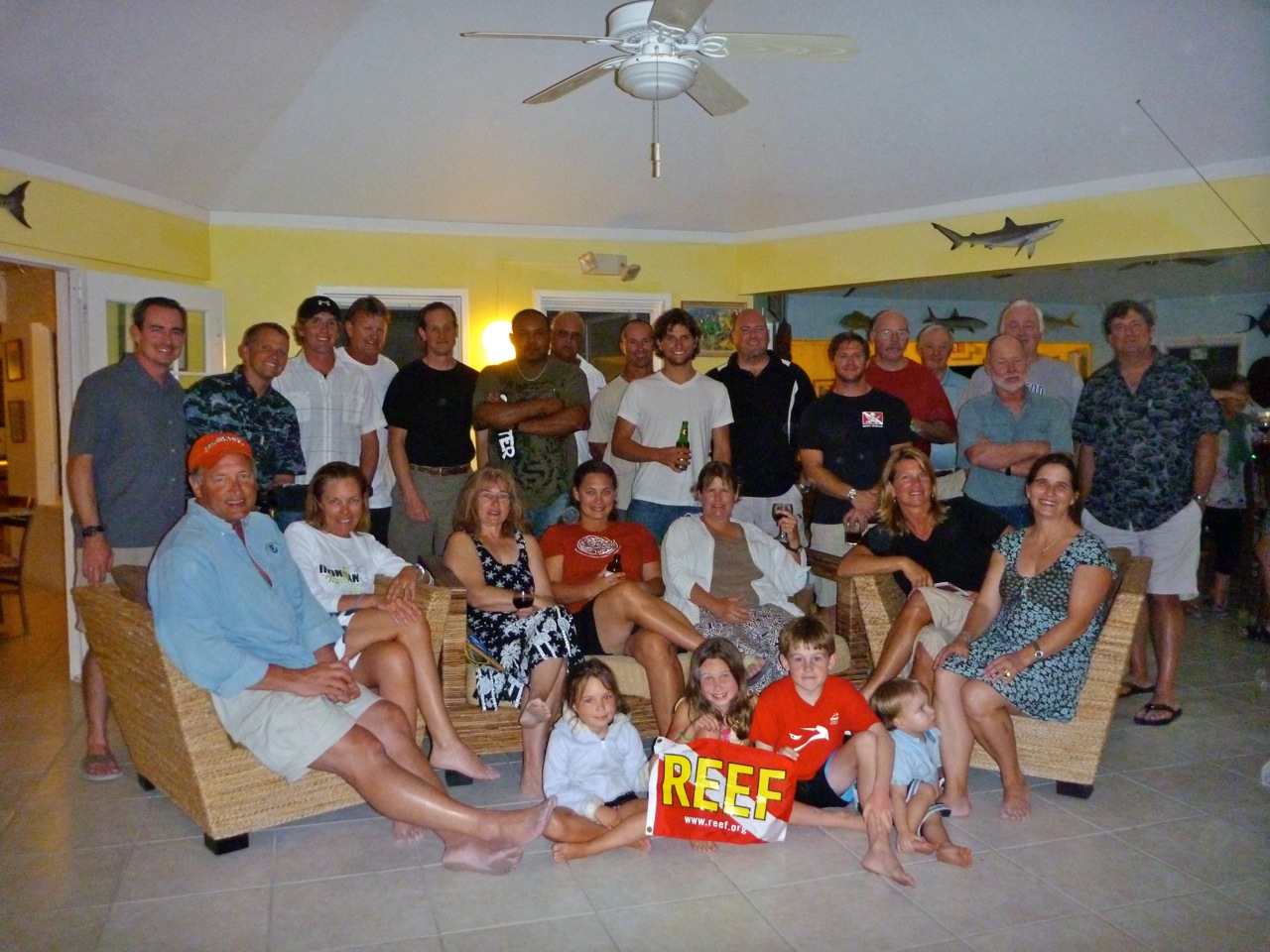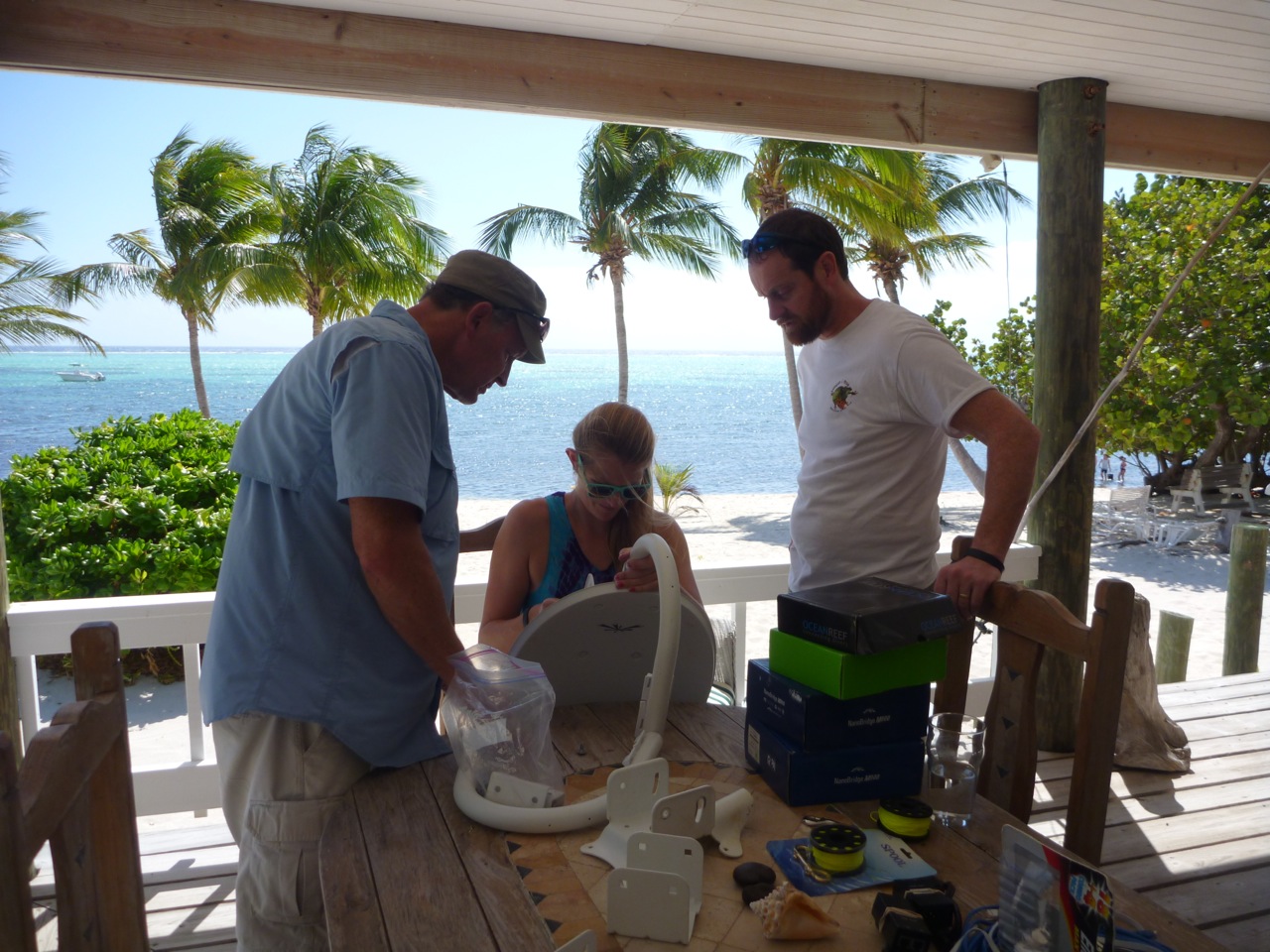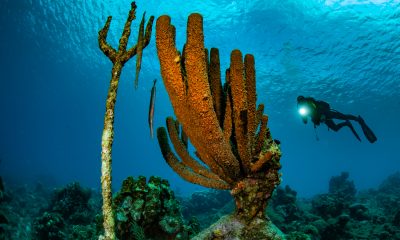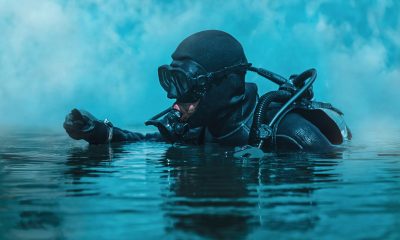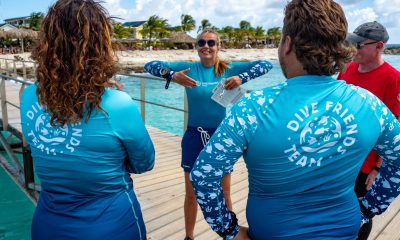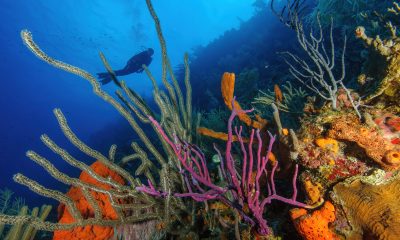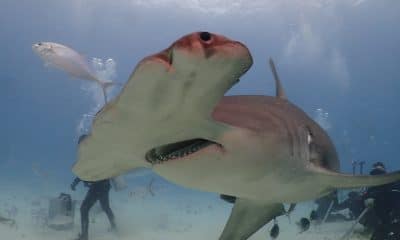News
Inspiring the Next Generation to Save the Iconic and Endangered Nassau Grouper
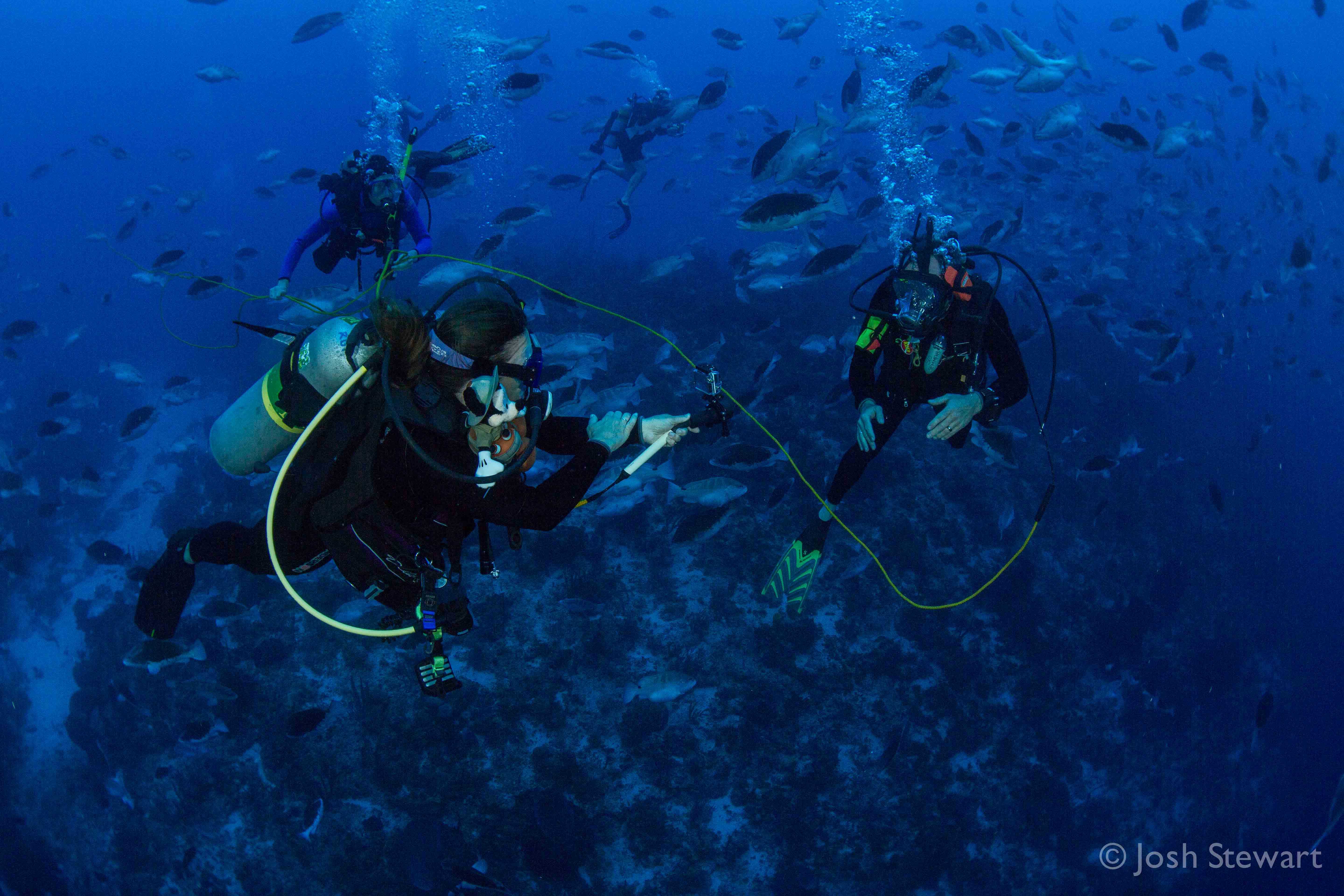
Live underwater webcasts from protected spawning site to local classrooms, and beyond, will visually teach important conservation lessons
As the winter full moon approaches, the Southern Cross Club on Little Cayman prepares for the annual arrival of the Grouper Moon Project team. Each year from late January to early February, scientists and volunteers of the Reef Environment Education Foundation (REEF) join staff from the Cayman Islands Department of the Environment (DOE) to document the last healthy, active and protected Nassau Grouper spawning site just off Little Cayman. The Southern Cross Club and others in the local community provide vital support to the team, recognizing that it takes an entire community to bring this historical and endangered species back from the brink of extinction.
In addition to documenting fish activity and population for valuable research data, the project also reaches out to local school children hoping to inspire them to join the conservation effort. It does this largely by streaming live video on the Internet from Little Cayman to local classrooms where children can see on a computer the work being done through the Grouper Moon Project. Two live webcasts are planned from underwater; one of them from the aggregation site where a scientist in scuba gear diving among the fish will show students what happens when Grouper spawn and why they are vulnerable at this time. He will also answer their questions about the mysterious and solitary fish that travels long distances to spawn at this site on Little Cayman. This year the webcasts are being streamed to classrooms in 10 schools on Grand Cayman, 3 schools on Cayman Brac, and for first time, the small school on Little Cayman.
“We’ve been expanding every year, adding more schools to the program because we get such good response,” says REEF educator Todd Bohannon, who with guidance from REEF scientists has developed the education curriculum. The webcasts lessons will be streamed from the aggregation site off the west coast of Little Cayman, from project headquarters at a house near the Southern Cross Club and from Bloody Bay Wall.
“The kids have an immediate connection to the lessons because it’s their history,” says Bohannon, who facilitates the webcasts between the scientists and the classrooms, fielding questions from the students. “They need to see the threat to the fish and these webcasts allow them to see it right in front of their eyes. We are giving them the tools they need to protect their environment and they are very enthusiastic, super smart and super excited.”
The hope is that by giving Caymanian kids a chance to see first hand what the scientists are doing to save the grouper, it will inspire them to continue the conservation work. Bohannon says the response from the children of Cayman Brac as been outstanding, and this year family evening events are planned.
“I can tell the Brac kids are talking to their families about the program because of their questions regarding fishing,” says Bohannon. “They get really excited, their reaction and comments are richer, and I like that.”
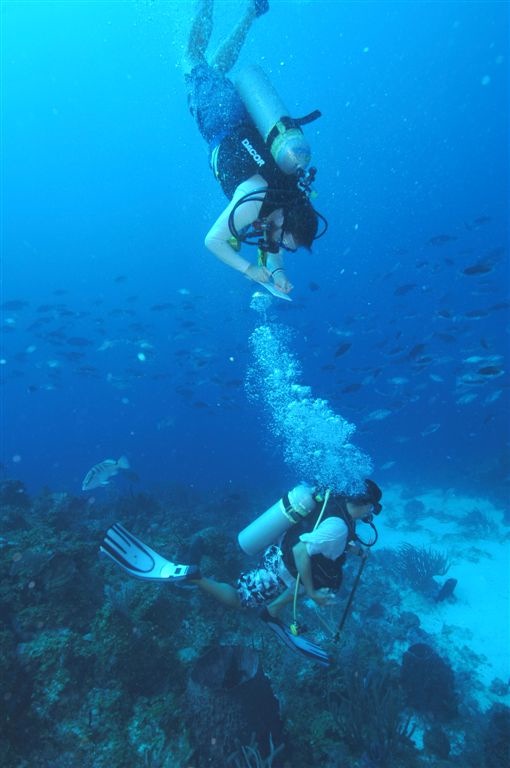 Although they’ve never seen the live feeds before, the students of the Little Cayman Education Service (LCES) School have always been aware of what happens on their island during the Grouper Moon.
Although they’ve never seen the live feeds before, the students of the Little Cayman Education Service (LCES) School have always been aware of what happens on their island during the Grouper Moon.
“They know what’s going on in Little Cayman when we come in and infiltrate the island!” says Bohannon. Last year Internet problems prevented a webcast in their classroom, so the Grouper Moon team made a personal visit to the classroom. “They loved it – it was great!”
Some of the live webcast lessons will be broadcasted from the porch at Peter Hillenbrand’s house near the Southern Cross Club. Hillenbrand, owner of the resort and a dedicated conservationist, is happy to have his house become “Grouper Moon central.” He enjoys being involved in the project and watching the marine scientists teach important lessons from his porch.
“The live broadcasts are one of the coolest learning tools I have ever seen,” he says. “It brings the Grouper Moon right into the class room, and there is nothing more important that educating our children about the world that surrounds them. There is not a better way to be amazed and learn other than being there yourself.”
Peter Hillenbrand and his team at the Southern Cross Club have been hosting the scientists and volunteers since the project began more than 12 years.
“We just take over the place – everyone is crashed out,” laughs a grateful Todd Bohannon, speaking for the entire Grouper Moon team. “This contribution is huge from a logistical point of view – Pete and his team always help out no matter what we need.”
“How do I prepare my house for the invasion? Ha! Well, I guess I try to make sure the sheets and towels are all clean, and my rum supply is abundant!” jokes Hillenbrand.
The good-natured camaraderie of the team enables and supports important conservation work being done. Nassau grouper has historically been one of the Caribbean’s most economically important fish, but intense harvesting during spawning aggregations has placed them on the endangered list. REEF is a volunteer organization and DOE has a limited research budget, so the project depends on volunteers, donations, fundraising and grants. Supporting the study are the Disney Worldwide Conservation Fund, Lenfest Ocean Program of the Pew Charitable Trusts, the NOAA International Coral Reef Conservation Program, the J. Edward Mahoney Foundation, and PADI Project AWARE. The Grouper Moon Project also relies on help from the Southern Cross Club and Peter Hillenbrand, the Little Cayman Beach Resort, Reef Divers, Brac Reef Resort, Divetech and others in the Cayman community.
Grouper Moon Project leaders say ultimately the salvation of the Nassau grouper depends on everyone who cares, doing their part to save the species – then carrying the message and passion to others. This year a few classrooms in the U.S. are participating in the live webcasts, and the team includes a couple of educators from the Bahamas, which helps the whole Caribbean.
“It’s vital for the success of the Grouper Moon Project to get the community involved,” says Todd Bohannon. “To have it last into perpetuity, you need to get the kids involved and you need to have the backing of the community.”
Each video session will begin at 11:45 am and continue for about an hour on designated dates. For more information and daily updates on the Grouper Moon Project visit www.groupereducation.edublogs.org.
Webcast Schedule:
Friday, Feb 6 at 11:45 am
Monday, Feb 9, 11:45 am
Tues, Feb 10, 11:45 am
Wed, Feb 11, 11:45 am (Backup Date)
(Cayman Time – CST)
About the Southern Cross Club
The casually sophisticated Southern Cross Club Fish & Dive Resort is Little Cayman’s original resort. It features 14 beachfront bungalows complete with a top-rated, professional in-house diving and fishing operation. A unique blend of rusticity and elegance the resort is often described as “Barefoot Luxury”. Guests can expect friendly and diligent service, delicious food, inviting rooms with breath-taking views and a comfortable dive boat ― a few of the things that bring them back year after year. Little Cayman is renowned for its breath-taking and pristine coral reefs and spectacular dive adventures. The resort’s beach-based location also provides flats fisherman with access to Bonefish and Permit just minutes away.
For reservations or more information:
Telephone: +1 (800) 899-CLUB (2582)
E-mail info@southerncrossclub.com
Website: www.southerncrossclub.com
Facebook: www.facebook/SouthernCrossClub
Blogs
Northern Red Sea Reefs and Wrecks Trip Report, Part 3: The Mighty Thistlegorm

Jake Davies boards Ghazala Explorer for an unforgettable Red Sea diving experience…
Overnight, the wind picked up, making the planned morning dive a bit bumpy on the Zodiacs to the drop point on Thomas Reef. There, we would dive along the reef before descending through the canyon and then passing under the arch before ascending the wall with a gentle drift. The site provided great encounters with more pelagic species, including shoals of large barracuda, tuna, and bigeye trevally.
Once back on the boat, it was time to get everything tied down again as we would head back south. This time, with the wind behind us, heading to Ras Mohammed to dive Jackfish Alley for another great gentle drift wall dive before then heading up the coast towards the Gulf of Suez to moor up at the wreck of the Thistlegorm. This being the highlight wreck dive of the trip and for many onboard, including myself, it was the first time diving this iconic wreck. I had heard so much about the wreck from friends, and globally, this is a must on any diver’s list. Fortunately for us, there was only one other boat at the site, which was a rarity. A great briefing was delivered by Ahmed, who provided a detailed background about the wreck’s history along with all the required safety information as the currents and visibility at the site can be variable.

Kitting up, there was a lot of excitement on deck before entering the water and heading down the shoreline. Descending to the wreck, there was a light northerly current which reduced the visibility, making it feel more like the conditions that can be found off the Welsh coast. At 10m from the bottom, the outline of the wreck appeared as we reached the area of the wreck which had been bombed, as our mooring line was attached to part of the propeller shaft. Arriving on deck, instantly everywhere you looked there were many of the supplies which the ship was carrying, including Bren Carrier tanks and projectiles that instantly stood out.

We headed around the exterior, taking a look at the large propeller and guns mounted on deck before entering the wreck on the port side to take a look in the holds. It was incredible to see all the trucks, Norton 16H, and BSA motorcycles still perfectly stacked within, providing a real snapshot in time.

Overall, we had four dives on the Thistlegorm, where for all of the dives we were the only group in the water, and at times, there were just three of us on the whole wreck, which made it even more special, especially knowing that most days the wreck has hundreds of divers. Along with the history of the wreck, there was plenty of marine life on the wreck and around, from big green turtles to batfish, along with shoals of mackerel being hunted by trevally. Some unforgettable dives.

The final leg of the trip saw us cross back over the Suez Canal to the Gobal Islands where we planned to stay the night and do three dives at the Dolphin House for the potential of sharing the dive with dolphins. The site, which included a channel that was teeming with reef fish, especially large numbers of goatfish that swam in large shoals along the edge of the reef. These were nice relaxing dives to end the week. Unfortunately, the dolphins didn’t show up, which was okay as like all marine life they are difficult to predict and you can’t guarantee what’s going to be seen. With the last dive complete, we headed back to port for the final night where it was time to clean all the kit and pack before the departure flight the next day.

The whole week from start to finish on Ghazala Explorer was amazing; the boat had all the facilities you need for a comfortable week aboard. The crew were always there to help throughout the day and the chefs providing top quality food which was required after every dive. The itinerary providing some of the best diving with a nice mixture of wreck and reef dives. I would recommend the trip to anyone, whether it’s your first Red Sea liveaboard in the Red Sea or you’re revisiting. Hopefully, it’s not too long before I head back to explore more of the Red Sea onboard Ghazala Explorer.

To find out more about the Northern Red Sea reef and wrecks itineraries aboard Ghazala Explorer, or to book, contact Scuba Travel now:
Email: dive@scubatravel.com
Tel: +44 (0)1483 411590
Photos: Jake Davies / Avalon.Red
Blogs
Northern Red Sea Reefs and Wrecks Trip Report, Part 2: Wall to Wall Wrecks

Jake Davies boards Ghazala Explorer for an unforgettable Red Sea diving experience…
The second day’s diving was a day full of wreck diving at Abu Nuhas, which included the Chrisoula K, Carnatic, and Ghiannis D. The first dive of the day was onto the Chrisoula K, also known as the wreck of tiles. The 98m vessel remains largely intact where she was loaded with tiles which can be seen throughout the hold. The stern sits at 26m and the bow just below the surface. One of the highlights of the wreck is heading inside and seeing the workroom where the machinery used for cutting the tiles are perfectly intact. The bow provided some relaxing scenery as the bright sunlight highlighted the colours of the soft coral reef and the many reef fish.

Following breakfast, we then headed to the next wreck, which was the Carnatic. The Carnatic is an 89.9m sail steamer vessel that was built in Britain back in 1862. She ran aground on the reef back in 1869 and remains at 27m. At the time, she was carrying a range of items, including 40,000 sterling in gold. An impressive wreck where much of the superstructure remains, and the two large masts lay on the seafloor. The wooden ribs of the hull provide structures for lots of soft corals, and into the stern section, the light beams through, bouncing off the large shoals of glass fish that can be found using the structure as shelter from the larger predators that are found outside of the wreck.

The final wreck at Abu Nuhas was the Ghiannis D, originally called ‘Shoyo Maru,’ which was 99.5m long and built in Japan back in 1969 before becoming a Greek-registered cargo ship in 1980. The ship then ran aground on the reef on April 19th, 1983, and now sits at the bottom at a depth of 27m. Heading down the line, the stern of the ship remains in good condition compared to the rest of the hull. The highlight of the wreck, though, is heading into the stern section and down the flights of stairs to enter the engine room, which remains in good condition and is definitely worth exploring. After exploring the interior section of the ship, we then headed over to see the rest of the superstructure, where it’s particularly interesting to see the large table corals that have grown at the bow relatively quickly considering the date the ship sank. After surfacing and enjoying some afternoon snacks, we made sure everything was strapped down and secured as we would be heading north and crossing the Gulf of Suez, where the winds were still creating plenty of chop.

The next morning, it was a short hop to Ras Mohammed Nature Reserve for the next couple of days of diving. The 6am wake-up call came along with the briefing for the first site we would be diving, which was Shark & Yolanda. The low current conditions allowed us to start the dive at Anemone City, where we would drift along the steep, coral-filled wall. These dives involved drifts, as mooring in Ras Mohammed wasn’t allowed to protect the reefs. As a dive site, Shark & Yolanda is well-known and historically had a lot of sharks, but unfortunately not so many in recent years, especially not so early in the season. However, there was always a chance when looking out into the blue.

The gentle drift took us along the steep walls of the site, with plenty of anemone fish to be seen and a huge variety of corals. It wasn’t long into the dive before we were accompanied by a hawksbill turtle, who drifted with us between the two atolls before parting ways. Between the two reefs, the shallow patch with parts of coral heads surrounded by sand provided the chance to see a few blue-spotted stingrays that were mainly resting underneath the corals and are always a pleasure to see. With this being the morning dive, the early sunlight lit up the walls, providing tranquil moments. Looking out into the blue, there was very little to be seen, but a small shoal of batfish shimmering underneath the sunlight was a moment to capture as we watched them swim by as they watched us.

Towards the end of the dive, we stopped at the wreck of the Jolanda where the seafloor was scattered with toilets from the containers it was carrying. This provided a unique site to make a safety stop, which was also accompanied by a large barracuda slowly swimming by, along with a hawksbill turtle calmly swimming over the reef as the sun rays danced in the distance.
For the next dive, we headed north to the Strait of Tiran to explore the reefs situated between Tiran Island and Sharm El Sheik, which were named after the British divers who had found them. We started on Jackson before heading to Gordons Reef, where we also did the night dive. All the atolls at these sites provided stunning, bustling coral reefs close to the surface and steep walls to swim along, which always provided the opportunity to keep an eye out for some of the larger species that can be seen in the blue. Midwater around Jackson Reef was filled with red-toothed triggerfish and shoals of banner fish, which at times were so dense that you couldn’t see into the blue. Moments went by peacefully as we enjoyed the slow drift above the reef, watching these shoals swim around under the mid-afternoon sun.

The night dive at Gordon’s Reef was mainly among the stacks of corals surrounded by sand, which was great to explore under the darkness. After some time circling the corals, we came across what we were really hoping to find, and that was an octopus hunting on the reef. We spent the majority of the dive just watching it crawl among the reef, blending into its changing surroundings through changes in colour and skin texture. It’s always so fascinating and captivating to watch these incredibly intelligent animals, in awe of their ability to carry out these physical changes to perfectly blend into the reef. Before we knew it, it was time to head back to the boat to enjoy a well-deserved tasty dinner prepared by the talented chefs onboard.
Check in for the 3rd and final part of this series from Jake tomorrow!
To find out more about the Northern Red Sea reef and wrecks itineraries aboard Ghazala Explorer, or to book, contact Scuba Travel now:
Email: dive@scubatravel.com
Tel: +44 (0)1483 411590
Photos: Jake Davies / Avalon.Red
-

 News3 months ago
News3 months agoHone your underwater photography skills with Alphamarine Photography at Red Sea Diving Safari in March
-

 News3 months ago
News3 months agoCapturing Critters in Lembeh Underwater Photography Workshop 2024: Event Roundup
-

 Marine Life & Conservation Blogs2 months ago
Marine Life & Conservation Blogs2 months agoCreature Feature: Swell Sharks
-

 Blogs2 months ago
Blogs2 months agoMurex Resorts: Passport to Paradise!
-

 Blogs2 months ago
Blogs2 months agoDiver Discovering Whale Skeletons Beneath Ice Judged World’s Best Underwater Photograph
-

 Gear Reviews3 months ago
Gear Reviews3 months agoGear Review: Oceanic+ Dive Housing for iPhone
-

 Marine Life & Conservation2 months ago
Marine Life & Conservation2 months agoSave the Manatee Club launches brand new webcams at Silver Springs State Park, Florida
-

 News3 months ago
News3 months agoWorld’s Best Underwater Photographers Unveil Breathtaking Images at World Shootout 2023


